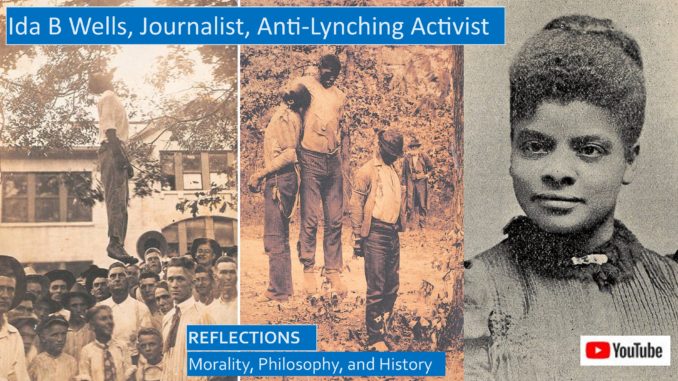
We often encounter whites who contest the history of lynchings and race riots, who believe that the history of lynchings is radical-left communist propaganda that has no basis in fact. To counter this, we offer the history and reporting of Ida B Wells, a brave black woman of modest circumstances who chose to crusade against the evils of lynchings and murders of blacks that go unpunished, brave because she risked death at the hands of white supremacists who detested the truths she was printing in the newspapers of her day.
YouTube video: https://youtu.be/sLDHs0AigvY
SlideShare script for this video, https://www.slideshare.net/BruceStrom1/what-happened-at-vatican-ii-embracing-democracy-and-modernity
How many blacks were lynched and murdered after the Civil War? Studies of newspapers and other sources estimate that up to 6,400 Americans were lynched, many studies estimate about 4,500 total deaths, about three quarters black. It is unclear whether this includes the number of blacks who died in race riots around the early twentieth century, but this does not include other reports of mass graves of blacks worked to death as convict laborers in the mines and on especially cruel plantations. Although we have not found any speculation of the true numbers of blacks who died, likely the true numbers of blacks who were lynched and murdered numbered well over ten thousand souls.
We will periodically pause the reports of gruesome, grisly, gory lynchings, which are necessary to acknowledge that they really did happen, and could happen again, with essays on Civil Rights topics by Ida B Wells.
EARLY DAYS OF IDA B WELLS
Ida B Wells was born in Mississippi during the Civil War, which means she would not have remembered when she was freed by the Emancipation Proclamation by the end of the war. Her father, Jim Wells, was active in the Mississippi Republican Party, braving the KKK vigilante justice that discouraged blacks from voting and participating. Her parents encouraged her to stand up for her rights. The childhood memories of Ida B Wells included her mother pacing the floor at night when her father was at a political meeting, wondering and praying, would he arrive home alive?
The young adult pictures of Ida B Wells look like the pictures of a teenager, and she was forced to grow up and start working very early. When she was sixteen and out-of-town visiting her grandparents, yellow fever struck, and both her parents passed away from the plague. She rushed back home when she heard the news, only to find out that her father’s Masonic Lodge brothers were planning to divvy up her siblings among several families. Ida B Wells, although she was only sixteen at the time, firmly stated that she would do everything she could to keep the family together. She had not even finished the equivalent of high school, but she had her dress lengthened, lied about her age, and took a job as an elementary school teacher. She was under-qualified, and she had to study herself to complete her education.
To earn more money, she got a job teaching school in Memphis, Tennessee, and soon started working for local black newspapers. She wrote biting articles and editorials under the pen name of Iola, the Princess of the Press, she became the newspaper’s editor and publisher as well as a writer, and in 1889 became co-owner of the black newspaper, Memphis Free Speech and Headlight. She married fellow journalist and attorney Ferdinand Lee Barnett, they had five children together.
IDA B WELLS, HER CAREER AS A JOURNALIST
Ida B Wells risked her life by reporting on the racial violence in the Deep South. In early March, 1892, three black businessmen, including Thomas Moss, a close friend, were the victims of a lynching incident. The initial incident was a squabble between white and black boys over a game of marbles, one of the white fathers whipped one of the black boys, and black men protested the whipping. That night a white mob stormed the blacks who hung out at the People’s Grocery Store and were met with gunfire from blacks who were guarding the store. The next day the white mob returned, threw thirty blacks in jail, looted the store, and terrorized the neighborhood blacks. Another white mob raided the jail, and lynched the three black businessmen, whose store successfully competed against another white grocery store nearby.
Historically, lynchings were justified by the myth that black men were eager to rape white women, and that white womanhood needed to be protected. Spurred by her knowledge of the details of this lynching of a dear friend, Ida B Wells started to research the history of other lynchings, discovering that for most lynchings had no connection to any intimate acts, and where there was intimacy, the white woman consented, which was so repugnant that it enraged white men of the day.
Ida B Wells reported on this lynching and three other lynchings of eight black men in one week in late May, 1892, five for rape, though as Ida B Wells wrote, “Nobody in this part of the country believes the old thread-bare lie that Negro men rape white women.” Ida B Wells recalls that her business partner had to leave town to escape the mob that ransacked the office and destroyed the building, and that “letters and telegrams sent to me in New York where I was vacationing advised me that bodily harm awaited my return. Creditors took possession of the newspaper office and sold the outfit, and the ‘Free Speech’ was as if it had never been.” The sheriff did nothing, the courts did nothing, and even if the case had made it to the courts, no jury would convict white men for crimes committed against blacks.
Ida B Wells moved north to Harlem, accepting a position with the newspaper, New York Age, and continued her anti-lynching campaign in articles and editorials. Was she able to move her possessions to New York? We hope so, Dr Wikipedia does not mention a mob destroying her house in Memphis. Soon afterwards she gives a speech to the National Press Association, she proclaims, “The lyncher has become so bold, he has discarded his mask and the secrecy of night, has left the out-of-the-way village, and invaded the jails and penitentiaries of our largest cities, and hung and tortured his victims on the public streets. Not content with this, Arkansas furnishes the spectacle of a woman vindicating her honor by setting fire to a living being, who, as the flames lick his burning flesh, dies protesting his innocence to the crowd of five thousand who looked on and applauded the act in ghoulish glee. A fifteen-year-old girl in Louisiana, suspected of poisoning a whole family is promptly hung on that suspicion; three reputable citizens of Memphis were taken from the jail and shot to death for prospering too well in business and defending themselves and their property; one of the journals which was a member of your organization has been silenced by the edict of the mob which declared there shall be no such thing as ‘Free Speech’ in the South.”
MORE MEMPHIS LYNCHINGS
The Reconstruction Era had ended, the federal troops had left the South, and since the southern sheriffs and police were now in charge, ever year their outrages against blacks became more and more brazen. Ida B Wells sensed this sliding into the abyss: “Lynchers belong to the race which holds Negro life cheap, which owns the telegraph wires and newspapers. They write reports justifying lynching by painting the Negro as black as possible, and those reports are accepted by the press association and the world without question or investigation. The mob spirit has increased with alarming frequency and violence. Over a thousand men, women and children have thus been sacrificed the past ten years. Masks have long since been thrown aside and the lynchings now take place in broad daylight. The sheriffs, police and state officials stand by and see the work well done. The coroner’s jury is often formed among those who took part in the lynching and a verdict, ‘Death at the hands of parties unknown to the jury’ is rendered. As the number of lynchings have increased, so has the cruelty and barbarity of the lynchers.”
LETTER OF ENCOURAGEMENT
The abolitionist leader, Frederick Douglass, wrote to Ida B Wells in late 1892,
“Dear Miss Wells, Let me give you thanks for your faithful paper on the lynch abomination now generally practiced against colored people in the South. There has been no word equal to it in convincing power. I have spoken, but my word is feeble in comparison.”
“BRAVE WOMAN! You have done your people and mine a service which can neither be weighed nor measured. If American conscience were only half-Christianized, if American moral sensibility were not hardened by persistent infliction of outrage and crime against colored people, a scream of horror, shame and indignation would rise to Heaven wherever your pamphlet shall be read.”
“But alas! Even crime has power to reproduce itself and create conditions favorable to its own existence. It sometimes seems we are deserted by earth and Heaven, yet we must still think, speak and work, and trust in the power of a merciful God for final deliverance.”
AN ARKANSAS LYNCHING
Ida B Wells tells us a story about a lynching that was put into motion by a theft by a white man that was enabled by the courts. “Hamp Biscoe was a hard-working, thrifty farmer, who lived near England, Arkansas, on a small farm with his family.” A white man then tried to collect on a fictional debt of a hundred dollars, a large sum for those days. “Biscoe refused to pay the demand. The white man brought suit, obtained a judgment for the hundred dollars and Biscoe’s farm was sold to pay the judgment.”
“The suit, judgment and subsequent legal proceedings appear to have driven Biscoe almost crazy and brooding over his wrongs he grew to be a confirmed lunatic. He would allow but a few men, white or colored, to come upon his place, as he suspected every stranger to be planning to steal his farm.”
His neighbor then tore down his fence, Biscoe threatened him, and his neighbor then secured a warrant for his arrest. Lawmen came, guns drawn, guns were fired, shooting both Biscoe and his wife. When the neighbors heard the news, of course a small mob gathered, coming to guard the guilty family. Afterwards the young son explained what happened next: “He saw a tall young man shoot his father and another man shot his pregnant mother. After they had killed them, his mother’s shooter pulled off her stockings and took two hundred dollars she had hid there.”
After the article was published, an investigator wrote to find out what had been done in the matter, received this answer from the sheriff: “The parties who killed Hamp Biscoe have never been arrested. The parties are still in the county. It was done by some of the citizens, and those who know will not tell.”
IDA B WELLS AND WEB DUBOIS CRITICIZE BOOKER T WASHINGTON
In 1904 Ida B Wells joined WEB DuBois in denouncing Booker T Washington in a symposium on “The Negro Problem from the Negro Point of View.” Washington was known as an accommodationist, but as the decades past many other black leaders complained that he was too accommodating, many started to wonder if he was more a part of the problem of continuing racists attitudes than part of the solution.
In an essay afterwards, Ida B Wells concedes that the supporters of Booker T Washington “cherish the most tender memories of the northern teachers who endured ostracism, insult and martyrdom, to bring the spelling-book and Bible to educate those who had been slaves,” founding many black schools. “Without these schools,” including Booker T Washington’s Tuskegee Institute, “Negroes would have been in a hopeless position; with their aid our race has made more remarkable intellectual and material progress in forty years than any other race in history. They have given us thousands of teachers for our black schools in the South, physicians to heal our ailments, druggists, lawyers and ministers. They have given us over two thousand black college graduates, over half of whom own property worth over one thousand dollars per capita.”
But they also note that Washington’s emphasis on providing trade education for blacks can limit the aspirations of blacks and give whites the wrong impression that a trade education is all that should be provided for blacks. Ida B Wells opines that: “Industrial education for the Negro is Booker T Washington’s hobby. He believes that for the masses of the Negro race an elementary education of the brain and a continuation of education for the hand is not only the best kind of education, but he knows it is the most popular with the white South. He knows also that the Negro is the butt of ridicule with the average white American,” who always enjoys a “joke that portrays the Negro as illiterate and improvident; a petty thief or a happy-go-lucky inferior.”
Ida B Wells plays the comedian and that “some will say Mr Washington represents the masses and seeks to depict the life and needs of the black belt. There is a feeling that he does not do that when he will tell a cultured body of women like the Chicago Women’s Club the following story:
‘Well, John, I am glad to see you are raising your ow hogs.’
‘Yessir, Mr Washington, ebber sence you done tole us bout raisin our own hogs, we niggers round here hab resolved to quit stealing hogs ad gwinter raise our own.’” To be sure you do not miss the point of the joke, she adds, “The inference is the Negroes of the black belt were hog thieves until the coming of Tuskegee.”
As we discussed in our video on Booker T Washington, there will always be a necessary tension between the schools of the accommodationist Booker T Washington and the activist WEB DuBois, and Ida B Wells necessarily was solidly in the activist camp. Washington in his autobiography does indeed condemn lynchings and supports black suffrage, but you also can find quotes by him elsewhere on these sensitive topics that are embarrassingly accommodating. The problem was that when he founded Tuskegee the only job blacks with a liberal education could find were as teachers or Pullman Railroad Porters, and the only other jobs whites would entrust to blacks were in agriculture or in the trades. From the very beginning his schools were heavily dependent on giving from white philanthropists, including many robber barons seeking to redeem themselves through their charity, and Booker T Washington was really a salesman, spending decades patiently calling on these wealthy individual year after year after year coaxing their donations. If Booker T Washington had shifted gears towards activism later in his life, and he lived into his nineties, these spigots of cash would have quickly turned off.
MORE GRUESOME, GORY, GRISLY LYNCHINGS
Ida B Wells tells of an especially brutal lynching where the black Sam Hose was accused of murdering his boss and assaulting his wife. There was no trial. As she reports, “a white man had been killed and a white woman was said to have been assaulted. That was enough. When Hose was found he had to die.”
The newspaper offered a five-hundred-dollar reward for his capture. Ida B Wells reports, “After he had been apprehended, it was publicly announced that he would be burned alive. Excursion trains were run, and bulletins were put up in the small towns.” “Many fair ladies drove out in their carriages to witness the torture and burning of this human being. Sam Hose’s ears were cut off, then his toes and fingers, and passed round to the crowd. His eyes were put out, his tongue torn out and flesh cut in strips with knives. Finally, they poured coal oil on him and burned him to death. They dragged his half-consumed trunk out of the flames, cut it open, extracted his heart and liver, and sold slices for ten cents each for souvenirs, all of which was published most promptly in the daily papers of Georgia and boasted over by the people of that section.”
HOW BLACK SUFFRAGE PREVENTS LYNCHINGS
Ida B Wells has more research and stories to press home the fact that black enfranchisement would be the only enduring solution to the problem of lynching and racial violence, that even when blacks have a small minority of public offices, this is enough to at least publicize any acts of barbarity and cruelty.
Ida B Wells explains, “With no sacredness of the ballot there can be no sacredness of human life itself. For if the strong can take the weak man’s ballot, when it suits his purpose to do so, he will take his life also. Having successfully swept aside the constitutional safeguards to the ballot, it is the smallest of matters for the South to sweep aside its own safeguards to human life. Thus ‘trial by jury’ for the black man has become a mockery, a plaything of the ruling classes and rabble alike. The mob says, ‘This people has no vote with which to punish us or the consenting officers of the law, therefore we indulge our brutal instincts, give free rein to race prejudice and lynch, hang, burn them when we please.’ Therefore, the more complete the disenfranchisement, the more frequent and horrible have been the hangings, shootings, and burnings.”
MORE GRUESOME, GORY, GRISLY LYNCHINGS
Ida B Wells has a section where she retells many tales of how lynched Negroes were burned alive. She reports that “in 1891 Ed Coy was burned to death in Texarkana, Arkansas. He was charged with assaulting a white woman, and after the mob had tied him to a tree, the men and boys amused themselves for some time sticking knives into Coy’s body and slicing off pieces of flesh. When they had amused themselves sufficiently, they poured coal oil over him and the woman in the case set fire to him. It was said that fifteen thousand people stood by and watched him burn. This was on a Sunday night, and press reports told how the people looked on while the Negro burned to death.”
Ida B Wells also reports that “in July 1893, in Bardwell, KY, CJ Miller was burnt to ashes. Since his death this man has been found to be absolutely innocent of the murder of the two white girls with which he was charged. But the mob would wait for no justification. They insisted that, as they were not sure he was the right man, they would compromise the matter by hanging him instead of burning. Not to be outdone, they took the body down and made a huge bonfire out of it.”
RACE RIOTS
The number of lynchings did gradually decrease over the years, perhaps partially as a result of the bright lights of constant publicity shone on this evil. During World War I many black men volunteered to serve in the military, and when they mustered out they expected progress in improving their civil rights, progress that was not forthcoming in a Wilson administration that had deeply racist attitudes. Perhaps individual lynchings declined since these returning black veterans were not only armed but knew how to use their arms. Instead, the white rage erupted in many race riots where the colored sections of many cities were burned down, with again no justice for the black man.
Ida B Wells reports, “A peaceful law-abiding hard-working group of about two hundred blacks gathered in their church at Hoop Spur, Alabama, to attend a lodge meeting” in the year 1919. “Suddenly at 11 PM, without warning, a volley of shots are fired into this free assembly. The lights go out and those who are not killed or wounded get away as quickly as possible. One white man, WA Adkins, is killed out in front of this church, whether by the men he is with or the guards out front will probably never be known.”
“No one knows how many of these peaceable unoffending Negroes were killed by this volley as the person who did this dastardly deed burned the church down the next day so no bullet holes in walls, broken windows or dead bodies of Negroes would show the conspiracy of whites to kill black people.”
“It is because that one white man was killed in front of the Negro church that night that a dozen Negroes are in the Arkansas penitentiary condemned to die.” What happened was the same basic story that we told in our video on the story in the 1619 Project. The cotton crop had been brought in, some of the share-cropping Negroes did not want to be cheated, they were negotiating too sharply to maximize their fair share of the crop. With the men in prison the mobs descended on their family’s houses, with nobody to protect them their wives and children were driven out, all their clothing and possessions were seized, and they were both husbandless and homeless, depending on public charity. This story goes on for fifteen pages.
Ida B Wells also reports on the East St Louis, Illinois, 1917 race riot that raged for a full day. More than a hundred Negroes were killed, thousands were driven from their homes, more than sixty Negro homes were burned, with half a million dollars in fire damages. Rather than putting down the riot, whites in the National Guard and the police department participated in the riot, sparking a Congressional investigation into this horrible event. She describes the events with multiple eyewitness that go on for forty ugly pages of evil callousness and uncaring cruelties against the blacks of the city.
GATOR BAITING WITH YOUNG BLACK TODDLERS
Lynching was all too common, but how about gator baiting? Was gator baiting a real thing? Gator baiting is when white hunter hunting gators use black toddlers as bait, tying them to a log near a swamp full of gators, and if they fuss and cry, so much the better, because such a ruckus will attract the gators much quicker. Dr Wikipedia says that “although scattered references to the supposed practice of gator baiting appeared in early 20th-century newspapers, there is no credible evidence that the stereotype reflected an actual historical practice,” but if you click on the footnote for the Scopes article, Snopes does reference credible evidence that gator baiting was a real thing, or at least was widely discussed, and we know that is true since Snopes has a copy of a grotesque lullaby written to sing babies to sleep, and we have postcards with little black babies with grinning gators. We all hope that this would happen rarely, what a horrible thought! We know that lynchings and murders of blacks were rarely prosecuted and tried, but we would hope that the rare Southern sheriff and jury would provide justice in a gator baiting case.
US CONGRESS FAILS TO PASS ANTI-LYNCHING BILL
We will excerpt this section from our video/blog on how the Nazi lawyers found precedents for drafting the Nuremberg Jewish Race Laws from the Jim Crow segregation codes in the Deep South before the Civil Rights era.
Mine eyes were opened when I first read about the history of the defeat of the anti-lynching bill in 1938. Eleanor Roosevelt and the black leaders were pushing FDR and Congress to pass the anti-lynching bill when the entire world was witnessing the horrors of the Nazi persecutions of the Jews. FDR was sympathetic, he explained to a colleague that “the southerners by reason of the seniority rule in Congress are chairmen of the key Congressional committees. If I come out for the anti-lynching bill, they will block every bill I ask Congress to pass to keep America from collapsing. I just can’t take that risk.” So, FDR had a choice, he could fight the Nazis, or he could fight lynching, but he could not do both. And, defeating the Nazis was an attainable goal.
Eleanor persisted in public speeches and her newspaper column in support of the anti-lynching campaign, constantly badgering her husband. Once she asked FDR, “Do you mind if I say what I think?” FDR replied, “You can say anything you like. I can always say, ‘Well, that is my wife; I can’t do anything about her.’” This supposed conflict was a good political way to push for civil rights without unduly antagonizing the powerful Deep South Senators and Congressmen.
What is distressing about this history was that the bill was not against lynching itself, but it put legal pressure on Southern judges and policemen to enforce the law and punish those who were guilty of lynching, instead of just ignoring the crime.

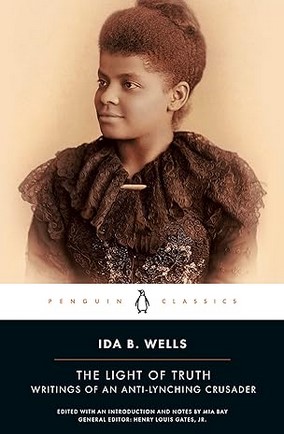
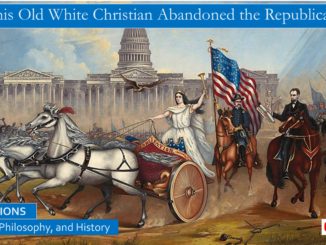
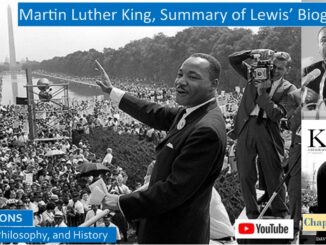
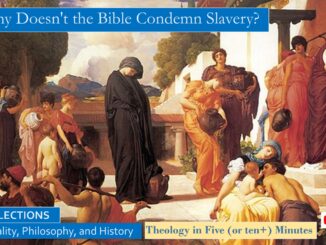
6 Trackbacks / Pingbacks